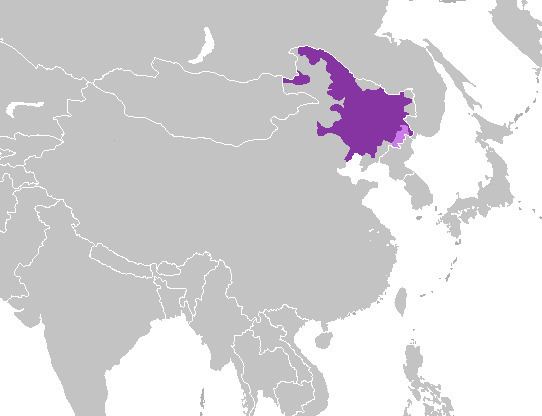Linguist list cmn-nem | ISO 639-6 dbiu | |
 | ||
Native to Jilin, Heilongjiang, Liaoning and Inner Mongolia provinces of China; (Overseas, United States-New York City, Russia-primarily in Primorsky Krai) Native speakers (82 million cited 1987) Language family Sino-TibetanChineseMandarinNortheastern Mandarin | ||
Northeastern Mandarin (simplified Chinese: 东北话; traditional Chinese: 東北話; pinyin: Dōngběihuà; literally: "Northeast Speech" or 东北官话/東北官話 Dōngběiguānhuà "Northeast Mandarin") is the subgroup of Mandarin varieties spoken in Northeast China with the exception of the Liaodong Peninsula.
Contents
Geographical distribution
Northeastern Mandarin varieties are spoken in the Northeastern part of China, in the provinces of Liaoning (except its southern part from Dalian to Dandong where Jiaoliao Mandarin is spoken), Jilin and Heilongjiang, and in some northern parts of Inner Mongolia. The number of speakers was estimated in 1987 as 82 million. Like other Mandarin dialects, differences between Northeastern Mandarin and other forms arise from the wide geographical distribution and cultural diversity of northern China. The Language Atlas of China divided Northeastern Mandarin into three subgroups, following a classification be Hè Wēi based on the occurrence of nasal initials in words having a zero initial in Beijing:
More distant varieties tend to be more similar to the Beijing dialect than closer ones, so that the speech of Harbin is closer to that of Beijing than that of Jilin and Changchun, which in turn are closer than that of Shenyang.
A form of Northeastern Mandarin (with some words from Udege and Nanai) has been spoken since approximately 1800 by the Taz people nearby in the Russian Far East, primarily in Primorsky Krai.
Overseas, Northeastern Mandarin is being spoken in increasingly larger communities in the Chinatowns of New York City in the United States.
Phonology
Northeastern Mandarin shares similarities with the Beijing dialect, such as a similar development of the entering tone and the preservation of initial [w], where the dialects of Hebei province, which surrounds Beijing, have [v]. For this reason, the Chinese dialectologist Li Rong argued that Beijing Mandarin could be grouped with northeastern dialects. However, in northeastern Chinese, final -ian or -üan is pronounced with an [æ] rather than with [ɛ] or [e] as in the standard. The [ʐ] initial of Beijing (spelled r- in pinyin) is generally omitted in northeastern varieties.
Cultural and regional identity
Although not considered a language in academic circles, Mandarin variants like Northeastern Mandarin often contribute to a strong regional identity. Because of its informal usage of words and tones, comedians often use Northeast dialects when performing.
The comedian Zhao Benshan is recognized nationwide for his performances which make humorous use of Northeastern dialect and the Er ren zhuan folk dance and song traditions of northeast people.
